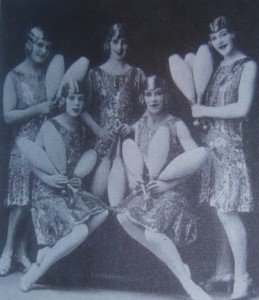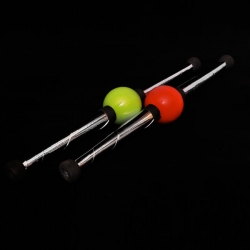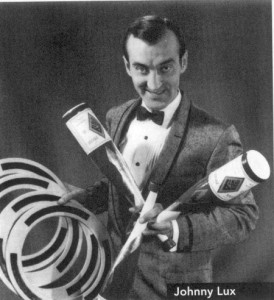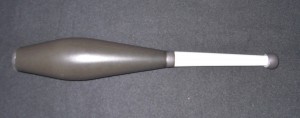In the final installment of this five part series, we’ll examine a very wide array of clubs that fit into the categories of lighted clubs, functional clubs, bottle clubs, unique clubs, and novelty clubs. I think this article will be the most interesting of the series for many readers.
Lighted Clubs
Unlike the other categories of clubs discussed so far in this series, lighted clubs are grouped by their function rather than by their construction, which has varied greatly. While many would think that lighted clubs are a recent invention, this is not the case. In 1912, the famed juggler and inventor Salerno (Adolf Behrend) created a set of electrically lit clubs that changed color as he juggled them. It should be noted that Edward Van Wyck advertised selling “Electric Clubs” in 1900, but it is not known what these clubs did. The first retail illuminated clubs that I’m sure of were made by Harry Lind. The December 1947 Juggler’s Bulletin reports that “Lind’s illuminated clubs are toughest to make. They have translucent sidewalls, batteries and a tiny light bulb inside. They’re used on a blacked-out stage.”
Many performers made their own lighted clubs. In the 1930s, British juggling troupe the Juggling Jewels, also known as the Carlton Sisters, performed with wonderful lighted clubs. An old edition of Billboard described the Juggling Jewels as “an all girl act that has won acclaim for their expertness in juggling tennis rackets, hoops, and clubs. An electrically illuminated club routine during an interval of darkness provides surprising flash as well as novel effects.”
Paul Bachman owns one of the Juggling Jewels’ lighted clubs. Below is a picture of this translucent club. It has an internal structure of small bulbs and wires attached to a battery.
In a Juggler’s Bulletin from May 1948, Bob Blau reported his recent new design in electrically illuminated clubs and his plans to add them to his act soon. In an interview with Blau in the Winter 1992 Juggler’s World Magazine, Bob stated that Massimiliano Truzzi “gave me permission to copy the battery-operated, lighted clubs he used in his juggle of five. My son, Dean, and I made up six for passing.”
Truzzi’s son, Marcello, wrote a description of his father’s act in 1996 and noted that Truzzi’s lighted clubs came about as a substitute for his usual finale of five flaming torches. He wrote, “In some venues, fire laws made it impossible to do the torches, so my father had some clubs made up with flashlight bulbs at each end with batteries attached, so he could simulate the effect in the darkness — though without such dramatic results.”
The Historical Juggling Props Exhibit contains a hand made lighted wooden juggling club from the 1960′s. It is one of nineteen such clubs that was used in a British circus act in the mid to late 60′s. It is powered by two AA batteries and has a small light bulb under the plastic cap. You can see it below.
In 2012, Olivier Caignart was given a somewhat similar lighted Indian club that had been found at a flea market. It is powered by a nine volt battery. It is pictured below.
Illuminated clubs with LED lights were first introduced by Aerotech from the UK in 1993. Aerotech then released the first programmable clubs a year and a half later. There are now numerous options for LED clubs made by a variety of manufacturers.
The first retail fluorescent clubs were American clubs made by Jugglebug. They were not electrically lit but were made of a material that absorbed light and then glowed in the dark. Below is an example of one of these Jugglebug clubs.
Functional Clubs
Functional clubs are clubs that have been modified or designed to perform a specific function that standard clubs could not do, at least easily. These are some of the most interesting and creative props around.
In 1985, Renegade Juggling developed the Numbers Club, now known as the 75mm club, at the request of Nick Gatto for Anthony Gatto to use. This club was lighter and thinner than standard European composite clubs. Anthony was able to flash 8 clubs using these and also used them in his initial training with 6 and 7 clubs. They were made available to the public shortly afterward and have been for sale ever since. Below is a picture of a Renegade Numbers club.
Dube also sold a numbers club starting in 1985. It was made with a cork body and wooden handle. Here is a picture of one.
The Renegadedesignlab Cuphead club was created in 2010 by Tom Kidwell of Renegade Juggling and is designed to catch balls or beanbags in the end. It was created by taking a Renegade Fathead club and cutting off the top of the shell, inverting the cut piece, and wielding it back onto the body of the club. Below is a picture of two Cuphead clubs as well as a video of the Jackson Ford demonstrating how they can be used.
The Renegadedesignlab Flathead club was designed in 2009 as a joint project of RdL (Renegadesignlab) and Stanislav Knyazkov of the Russian juggling team the Safarlagins. The main attribute is that this club can be placed on a table standing with the knob up, and then kicked to a juggler. This is the final trick of the Safarlagins’ act. The Flathead is a Renegade 95mm clubs with the top end of the club cut off.
The Renegadedesignlab Holy club was designed in 2010 as a joint project of RdL (Renegadesignlab) and Mike Gilligan, Jay Gilligan’s father. The hole in the club can accommodate another club, allowing for many creative tricks. Holy clubs are constructed from Dube Airfllite clubs.
Click here to see a video of Jay Gilligan demonstrating many of the tricks that can be done using Holy clubs.
Magnetic clubs were first created by Ameron Rosvall of Sweden. Click here to see a video of them in action and more information about their history, creation, and use. Click here to see additional video of magnetic clubs.
One of the most famous clubs of all time is Alexander Kiss’ “Dancing Club”, which he bounced up and down on his head while juggling seven rings. Contrary to popular belief, the club doesn’t have a spring in it’s handle. Instead, the bottom (end cap side) of the club is weighted and the bands that make up the body of the club act as a spring, flexing as the weighted portion moves up and down. In place of a traditional knob is a flat disk. Below is a video of Kiss using it.
The Transformer Club is a creation of prop innovator Jay Green. It appears to be a normal juggling club, but the bottom half of the club can be unscrewed to reveal a torch end. This prototype club is very well made and quite interesting. It is now in the Historical Juggling Props Exhibit. See the two following pictures of the Transformer Club.
Henrys Professional Juggling Equipment of Germany produces the sparkler club. While it closely resembles a skeleton club, it’s designed to hold a sparkler. These clubs consist of 4o pieces and are an alternative to torches and illuminated clubs. You can see one below.
Double handled clubs are made by Cabeza de Martillo of Chile. They allow the performer to catch either end or even juggling the middle as a ball. You can see them pictured below.
Box head clubs are the creation of Japanese juggler Yosuke Imai. They feature a square, cigar box-like end and four sided handles. This design allows for a variety of unique stacking and balancing tricks. A video of Yosuke Imai demonstrating these clubs is below.
Edward Van Wyck advertised selling both “Musical Clubs” and “Bell Clubs”, but I’ve not been able to find out anything about these. The Flying Karamazov Brothers used mallet-like clubs to play the marimba while juggling, which can be seen in the picture below.
The FKBs also used clubs with bells attached. See the following picture of Tim Furst with these clubs.
One of the oldest types of functional clubs are “bounding clubs.” These clubs were made to be bounced when the bottom end hits the floor. Edward Van Wyck sold bounding clubs at least as early as 1900, as they were advertised in his catalog from that year. Bobby May recalled that Victor Martyn of the Australian juggling duo Martyn and Florence also made bounding clubs in the early part of the twentieth century. They were cork clubs with a rubber bottom and were made specifically for rebounding off of the floor.
Passe Passe from France sells a modular club system which features a screw apart handle that can be used for a club body or a torch body.
Bottle Clubs
The term “bottle clubs” can mean either clubs made to look like bottles or clubs made from bottles. Both will be discussed here. The juggling of bottles goes back a very long time, but few jugglers care to juggle breakable props, so making clubs that resemble wine or other types of bottles has been fairly common. Ohio juggler Johnny Lux used composite clubs made to look like bottles. Here are pictures of Johnny with them and how they now look in the Historical Juggling Props Exhibit.
As I discussed in Part 3 of this series, Stu Raynolds made a wonderful hollow fiberglass bottle club that is much sought after today. Here are two of them donated by Tommy Curtin to the Historical Juggling Props Exhibit.
Steven Ragatz has created some very nice champagne bottle clubs, as can be seen below.
As I stated earlier, some jugglers use clubs made from bottles. This was a popular method of making clubs in Russia in the past and is still used by the Gerasimov Family today. You can see in the close ups of the following amazing video that the shell of their clubs are made from plastic bottles.
The best known clubs made from bottles are those associated with the Green Club Project. These homemade clubs were designed by Jon Poppele and are basically composite clubs that use plastic bottles for the body shell as well as for the handle wrap. These clubs are extremely durable and well balanced. You can learn how to make these clubs by clicking here and can see some examples in the picture below.
Unique Clubs
There are several clubs that, due to their construction or appearance, don’t fit into any other category. Five such clubs are included in this category of “unique clubs.”
The club shown below was created by Doug Couden, an American juggler specializing in school assembly programs in the 1940s. It’s cross sectional body is quite unique. This example is owned by Paul Bachman.
The clubs below are amazing metals clubs used by juggling legend Jenny Jaeger for many years. They are quite distinct in both their construction and appearance.
The crocheted club seen below was created by Erica Kelch -Slesnick in 2014. It has a wooden dowel and is stuffed with plastic bags. It actually juggles quite well.
Below are some custom made fiberglass clubs designed and owned by Dick Franco. The were made by Stu Raynolds and the bodies were patterned off of a Christmas ornament.
One of the most unique and well crafted kind of clubs are the porcelain clubs made by artist and juggler Jo Kamm. They juggle quite well but break when dropped. Below you can see a picture of one and view video of some being juggled and dropped.
Novelty Clubs
The term “novelty clubs” refers to clubs that are usually used for comedy and have little or no functional advantage to them. In fact, many of them are quite difficult, if not impossible to juggle.
IJA Founding Father Art Jennings famously used a comedy break-away club in his “Bum Juggler” act from the 1930s to the mid-1950s. The club contains a spring which, when released, causes the club to break into thirteen pieces, attached to each other by a chain. Art made this club himself and it is now owned by his son, Art Jennings Jr. This amazingly constructed club is pictured below.
Famous Australian comedy juggler Stan Kavanaugh used what might be called a “nesting club.” The December 1947 Juggler’s Bulletin says that Harry Lind “made a club for Juggler Stan Kavanaugh which would spring open in midair and drop three smaller clubs from it.”
Well known juggler and juggling historian Alan Howard used an “elastic club” in his act for a short time. It had a removable knob which was attached to the rest of the club by an elastic cord. The club was juggled and then the knob was detached and held while the rest of the club was thrown toward the audience. As the audience was startled, Alan would pull the club back to himself and catch it, completing the gag. This was based on a gag done by Tony Fercos.
The most common novelty clubs are giant clubs. Since I previously wrote an article about these clubs, which can be seen by clicking here, I won’t go in to any detail about them. However, the following video was not included in that article and so is included below.
Another example of novelty clubs are the “springy clubs” created by Christine Rhubarb from Boston, MA (USA). Their novelty rests in the fact that they are deceptively difficult to juggle. They can be seen in the following video.
Stu Raynolds made a hollow fiberglass club in the shape of a human leg. I would assume this was for a “club foot” joke, but I could be wrong. While I haven’t been able to locate one of these clubs or even a picture of one, I do have a picture of the mold for the club, which is owned by Cindy Marvell. It is below.
The claw club below, which actually does open and close, was made from a Dube European club by Mick Lunzer of the Dew Drop Jugglers. It was used in their spy-themed gold medal winning IJA Teams act from 1996.
As readers of this series have learned, the past 130 years have produced a huge variation in types of juggling clubs. I’ve learned a great deal about my favorite prop and I hope that you have been both educated and entertained by the results of my research. As you might note in the Functional Clubs section, new innovation is being done on a very regular basis, resulting in some very creative props. I encourage readers to brainstorm ideas for other original props. Perhaps a hundred years from now jugglers will look back and scoff at the idea that we all juggled composite clubs! I’ll close by sharing a club-like prop I’ve just begun to play with – the “Cain Club”.
































Comments 0
Thanks for this! Great article, was very interesting to read!
Here’s a video showing novelty miniature clubs. It’s a brief video of Gray, Austin, and Worth from 1941. They look like miniature Lind clubs.
https://www.youtube.com/watch?v=Y76i2qgkarM